About Busan and Korea
Conference Site : Busan
Busan, is located on the southeastern tip of the Korean peninsula. Busan is the second largest city in Korea. The natural environment of Busan is a harmonious relationship of mountains, rivers and sea. Its geography includes a coastline featuring superb beaches and scenic cliffs, mountains which provide excellent hiking and extraordinary views with hot springs scattered throughout the city. Busan enjoys four distinct seasons and a temperate climate that never gets too hot or too cold.
- SEA & BEACHdetail view
- FASHION & SHOPPINGdetail view
- WALKING & HIKINGdetail view
- HISTORY & TRADITIONdetail view
- CULTURE & UNIQUEdetail view
- FUN & FOODdetail view
- CITY TOUR BUSdetail view
- BUSAN HABOR TOURdetail view
SEA & BEACH
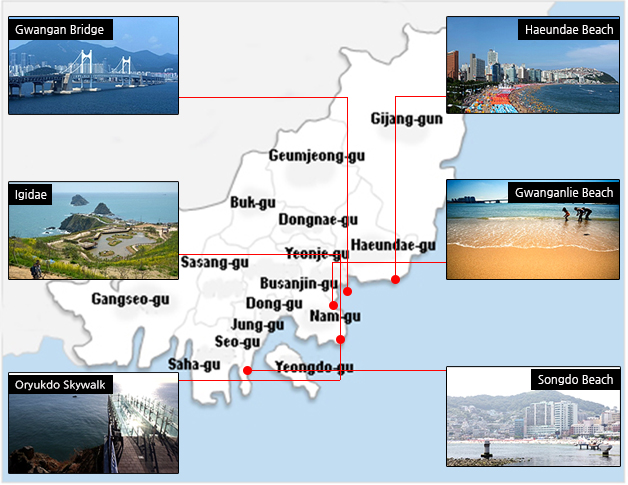
- Gwangan Bridge
- The Gwangan Grand Bridge is the largest marine complex floor bridge with a total length of 7.42km ranging and crossing the sea from 49 Plaza of Namcheon-dong, Suyeong-gu to Centum City of Haundae-gu. With the state-of-the-art lighting system installed, it provides artistic and formative beauty with over 100,000 colors of spectacular lighting which serves as an additional sight to see on the Gwangan Grand Bridge when it is well harmonized with the surrounding scene.. ▶ Getting there: Subway line 2 to Gwangan Station (Exits 3 and 5) → 700m in the direction of Gwangalli Beach
- Igidae
- In a cliff of Igidae’s coast, a stone Buddhist imaged rock stands to the sea as if he prays for safety of the ships passing by. Recently, dinosaur’s footprints were found in Igidae, so Nam-gu district office arranged this area and constructed a park where an outdoor stage and dinosaur models are provided for citizens’ enjoyment...
▶ Get off the intra-city bus at the back gate of Oryuk Islets SK View Apartments. The public bus numbers are
27, 131, village buses Namgu 2 and Namgu 2-1.
- Oryukdo Skywalk
- Iron columns were set up over a 35-meter-high coastal cliff, and a 15-meter glass bridge comprised of 24 glass plates and shaped like a horse’s hoof connect the iron columns. The bottom of the glass was specially produced with four attached 12-millimeter glass pieces coated with a bulletproof film that has a thickness of 55.49 millimeters, making the structure very safe. Visitors will be thrilled with the view of the waves while looking down through the transparent floor. The picturesque scenery of Oryukdo and Igidae allow for a picture-perfect photo backdrop, while it is also the best spot to see Daemado Island on sunny days...
▶ Get off the intra-city bus at the back gate of Oryuk Islets SK View Apartments. The public bus numbers are
27, 131, village buses Namgu 2 and Namgu 2-1.
- Haeundae Beach
- Haeundae boasts an ideal wide, sandy beach and shallow waters with gentle ripples. At the mention of 'Busan', 'Haeundae' is the first to spring to mind, and it surely is the city's representative spot. In particular, with the buildings and upscale hotels along the shoreline, the beach is well-known for its modern feel. ▶ Getting there: Subway line 2 to Haeundae Station (Exit 3 or 5) → 600m in the direction of Haeundae
- Gwanganlie Beach
- The key words for Gwangalli are youth, passion and luxury. Even the silence of the dawn shines at the sound of the waves lapping the sands and even the quiet seashore of the late afternoon awakens you to the value of life. Gwangalli surprises you because things transcend reality here. In Gwangalli, you are pleasantly surprised by small acts of compassion because you did not expect them. These are the attractions of Gwangalli and the reasons why you have to visit Gwangalli.. ▶ Getting there: Subway line 2 to Gwangan Station (Exits 3 and 5) → 700m in the direction of Gwangalli Beach
- Songdo Beach
- Songdo Beach is Korea’s first beach in the modern sense. Also known as the Naples of Asia, the beach’s popularity began to soar during the 60s and 80s. The beautiful coastline is frequented by tourists all year round. Songdo Beach has recently been refurbished as a sea-side park. Offshore breakwaters and underwater breakwaters protect the beach from yearly typhoons and to prevent loss of beach sand.
▶ Get off the intra-city bus at the back gate of Songdo beach. The public bus numbers are 7, 26, 71, 96, 6-1,
16, 17, 61, 161.
FASHION & SHOPPING
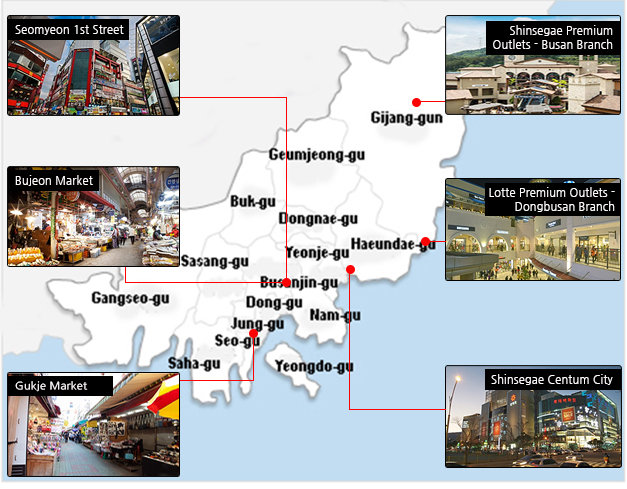
- Seomyeon 1st Street
- Seomyeon 1st Street usually covers the 80m section from Jungang-ro and Green Street through Bujeon Covered Stream and the 420m section, a cross-shape back street, from the back street next to the former Cheonwujang and the intersection of the former Mariposa to the LG Electronics Seomyeon Service Center. Since in the middle of 1980s, the street had embraced the young people’s tastes for fashion, accessory, cafe and beer, fast food and karaoke which were packed along the street, forming a brand new street. ▶ Getting there: Subway lines 1 and 2 to Seomyeon Station. Near Lotte Department Store.
- Bujeon Market
- Bujeon Market, proud as the largest nationwide, as well as in Busan, is a traditional market originated from products stands around Bujeon Station of Donghae Nambuseon Railway Line where peddlers came packed with agricultural and fishery products produced from Gijang, Seosaeng, Ilgwang and Wolnae in the vicinity of Busan after the Korean War. ▶ Getting there: Subway lines 1 and 2 to Seomyeon Station. Near Lotte Department Store.
- Gukje Market
- This market is a reminder that Busan was once the largest trade city in Korea. Gukje Market is large in scale and including various foreign items, a vast array of goods are offered at bargain prices.
▶ Getting there: Subway line 1 to Jagalchi Market Station (Exit 7) → Nampo intersection → BIFF Square,
300m in the direction of Gwangbok-ro
- Shinsegae Premium Outlets - Busan Branch
- Shinsegae Premium Outlets located at Gijang-gun, Busan offers over 180 shops from various famous international and domestic brands.
Operating Hours : Weekdays 10:30-21:00, Restaurants 11:00-21:00 ▶ Get off the intra-city bus at the back gate of Shinsegae Premium Outlets. The public bus numbers are 182,
188, 37, 1008.
- Lotte Premium Outlets - Dongbusan Branch
- Lotte Mall Dongbusan branch is a shopping complex featuring a premium outlet, a shopping mall, a Lotte Mart, and Lotte Cinema combined. Lotte Mall Greece Santorini theme, which has differentiated itself being not simply a vast area of a building, but offering an exotic shopping experience in a lighthouse with a gazebo, fountain square, Hera Rose Garden, and roof top garden. In addition, there is a variety of leisure and international fashion brands, sports stores, cosmetics shops, as well as new designer shops and entertainment services for children, such as play time and Lego shop. Also, local specialty stores with a good prices fulfill the needs of shoppers across various age groups. The mall houses a total of 550 brand stores. Enjoy a pleasant and relaxing break at the local restaurants of F&B outlets. There is also a large studio, as well as pottery and crafts stores in an alleyway of specialty shops.
▶ Get off the intra-city bus at the back gate of Lotte Premium Outlets . The public bus numbers are
100,181,185.
- Shinsegae Centum City
- The Shinsegae Centum City Department Store is registered in the Guinness Book of World Records as the world's largest department store. Not only does it contain clothes stores and eateries, but it is also the only place in Busan where shopping can be enjoyed along with an indoor ice rink, golf range, CGV movie theater and Spa Land which offers relaxation in the middle of the city, with views of the Suyeong River and the sea. This is a combined shopping and entertainment complex which can be enjoyed throughout the year. ▶ Getting there: Subway line 2 to Centum City Station (Exit 12)
WALKING & HIKING
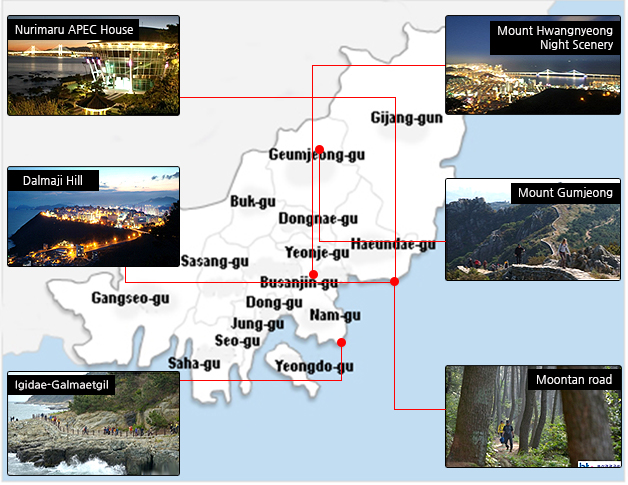
- Nurimaru APEC House
- After 2005 APEC Leader’s Summit, it gained its renown as high-level facility for international conferences. It is a tourist attraction representing Busan and gathers 4,000 to 5,000 visitors everyday. “Nurimaru”, meaning the top of the world, was built under blue prints of Korea’s traditional architecture “Jung Ja”. Inside the building, one can observe the numerous scenes from Leaders’ Summit.
▶ Getting there: Subway line 2 to Dongbaek Station (Exit 1) →
800m in the direction of Busan Westin Chosun Hotel → Inside Dongbaek Park
- Dalmaji Hill
- The Dalmaji Road is located on the side of Wausan Mountain and leads to Songjeong Beach beyond Haeundae Beach. It is a quiet path thick with cherry trees and pine trees, called the “15 curves road” for its panoramic vision of the boundless ocean. In addition, Moontan Road, located in Dalmaji Hill, was designed as a peaceful space where you can find your emotional stability gazing at the horizon under the moonlight. You can enjoy observing the moonrise from the road on Dalmaji Hill, which has been one of the eight scenic spots since ancient times as it boasts excellent views. ▶ Getting there: Subway line 2 to Jungdong Station (Exits 5 or 7) → 500m in the direction of Mipo intersection
- Igidae-Galmaetgil
- You can get there through a former salt pond at the edge of Gwangandaegyo Bridge over the sea which presents stunning night vistas. On Igidae, you would be succumbed by the compelling scenery such as the view of waves crashing on the rock pool, the spectacular look of Chimabawi Rock, as well as the view of Oryukdo Island from Nongbawi Rock. There is also Oryukdo Island that has been designated as National Cultural Heritage Scenic Spot No.24 with the background of the horizon lingering when you climb throughout Sataegol (Satae Valley).
▶ Get off the intra-city bus at the back gate of Oryuk Islets SK View Apartments. The public bus numbers are
27, 131, village buses Namgu 2 and Namgu 2-1.
- Mount Hwangnyeong
- Mount Hwangnyeong, boasting spectacular views, is a popular spot well-known for night hiking. With its amazing scenery of the city's buildings lights and the lights of the Gwangan Bridge reflecting off the waters beneath, the spot is considered a 'must-see' for visitors. The observatory located halfway up the mountain embraces Haeundae, the city and the surrounding sea in one gaze.
▶ Getting there: Subway line 2 to Namcheon Station (Exit 4) → Take bus no. 38 → 700m in the direction of
Mount Hwangnyeong
- Mount Gumjeong
- Mt. Geumjeongsan used to be called a patriotic mountain that was historically used to defend the nation. It also has one of Korea’s most prominent temples, Beomeosa Temple and Korea’s largest fortress, Geumjeongsanseong Fortress.
▶ Take the subway to Beomeosa Station on Subway Line #1, and leave by Exit 5 and 7. The take Bus 90, and
then get off at Beomeosa entrance.
- Moontan road
- Moontan Road Walking is a healthy and pleasant program based on the belief that ‘moonlight is effective in healing human sensitivity and emotions’. Participants can experience a variety of fun and interesting events during this occasion (ex: meditation stretching, moonlight music concert, meditation, etc.) along the 2.2km-long Dalmaji-gil Road. ▶ Getting there: Subway line 2 to Jungdong Station (Exits 5 or 7) → 500m in the direction of Mipo intersection
HISTORY & TRADITION
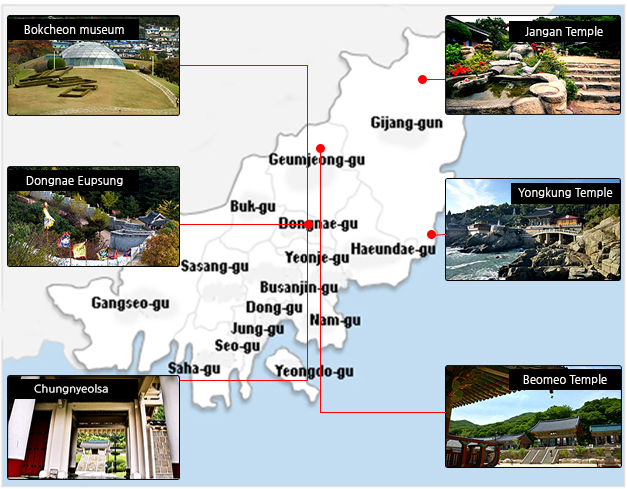
- Bokcheon museum
- Bokcheon Museum opened October 5, 1996 as an archaeological museum exhibiting relics excavated in the ancient tombs in Bokcheon-dong, which extend from the Samhan Dynasty to the Three Kingdom Period and modern history of Busan The 169 pieces of earthenware and iron objects discovered over a series of seven excavations are on exhibit. ▶ Take off at Dongnae Metro Station and proceed to No.4 Exit and then take village bus No.6
- Dongnae Eupsung
- Dongnae Eupsung is a site where a severe battle took place during the Imjin War. The remains at this place portray the history of Busan vividly. The overall fortress stretches out to 1.9㎞, and encompasses the area from the mountain behind Chungnyeol Shrine to the central part of Dongnae-gu. Festivals related to Dongnae Eupsung take place every year. ▶ Take off at Oncheojang Station and proceed to No.3 Exit and then take bus No.203
- Chungnyeolsa
- Chungnyeolsa is a sacred shrine, where the spirits of those who fought against the Japanese troops during the Japanese invasions of Korea of 1592, are enshrined. ▶ Take the subway to Chungnyeolsa Station on Subway Line #4, and leave by Exit 1
- Jangan Temple
- It is said that the Imjin War (Japan's Sixteenth-Century Invasion of Korea) had burnt the whole Jangansa Temple, which was remodeled in the 8th year of the King Injo (1631) then rebuilt by the great priest Tae Ur in the 16th year of Injo, and again in the 5th year of the King Hyojong, Wonjong, Hangneung. Chungmuk restored Daeungjeon, which is city-designated monument No. 37.. ▶ #482, Jangan-ro, Jangan-eup, Gijang-gu, Busan
- Yongkung Temple
- Compared to other Buddhist temples rooted deep in mountains, Haedong Yonggung Templ is located on the coast of the East Sea with dark blue sea water rolling below the foot of the temple as the name indicates. Therefore, it may be right to call it a water temple. It is a representative spot of Gijang that tourists, whether in groups or not, visit all year round. ▶ Get off the intra-city bus at the back gate of Yongkungsa. The public bus numbers are 100,181.
- Beomeo Temple
- Beomeosa was built by the great priest UiSang in 678 during the reign of King MunMu of the Silla dynasty, as one of ten HwaEom temples in Korea. It was established to realize the purpose of HwaEom which pursues life full of happiness and generosity. Along with HaeInsa and TongDosa, Beomeosa is one of the three largest temples in Young Nam province, and home to Buddhist cultural assets and famous great priests.
▶ Take the subway to Beomeosa Station on Subway Line #1, and leave by Exit 5 and 7. The take Bus 90,
and then get off at Beomeosa entrance.
CULTURE & UNIQUE
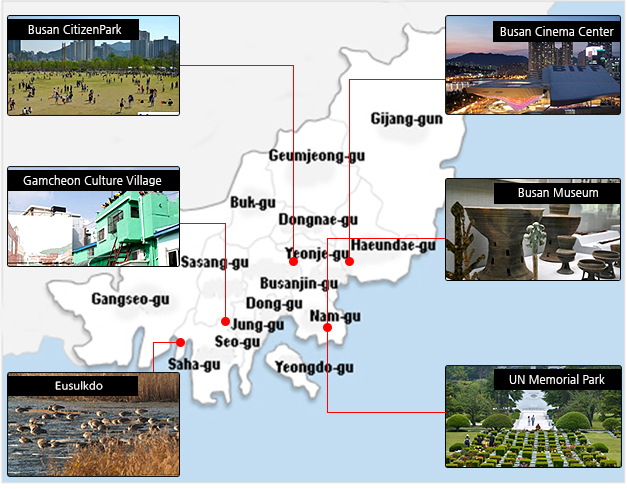
- Busan Citizen Park
- Busan Citizens Park is designed based on five major themes, which are Memory, Culture, Pleasure, Nature, and Participation. The park is well-known for its unparalleled design, hard to find in other parts of the world, encompassing new landscape, refreshment, and boundless imagination, with the area of 473,279㎡. In particular, the Hialeah Lawn Plaza has an area of 40,000㎡, which is six times bigger than a soccer field. ▶ Get off the intra-city bus at the back gate of Busan Citizen Park.. The public bus numbers are 33, 43, 63, 179.
- Gamcheon Culture Village
- Gamcheon Culture Village, in South Korea ,is a small village filled with art and history. Located on a mountainside in southern Busan, locals often compare the village’s view of dense buildings to Greece’s Santorini, Peru’s Machu Picchu and even Lego blocks for its shape and colorfulness. Inside the village, narrow alleys spread throughout the city like a maze where people are likely to run into multi-colored buildings, quirky art installations and stylish galleries. ▶ Take the subway to Toseong-dong Station on Subway Line #1, and leave by Exit 6. The village buses Seogu 2, 2-1.
- Eusulkdo
- There are many small and large delta areas such as Eusulkdo island and Ilwoongdo island etc. in the downstream area of the Nakdong river, and there are lots of preys such as plankton, shellfishes and small fish etc. for migratory birds as near the delta areas, the water is very shallow, there is lots of exchange between river water and sea water and mud flat is well developed at both sides of the river side. The reed forest near the delta area is also the place where lots of migratory birds come as the place is full of preys for migratory birds and safe nests.
▶ Get off the intra-city bus at the back gate of Eusulkdo. The public bus numbers are 55, 58, 58-1, 58-2, 168,
221, 520, 2000.
- Busan Cinema Center
- A place where cinema fanatics gather, the center has held special screenings of major directors and genres, introducing the public to high quality art house movies and at the same time bringing locally produced independent movies to people. The asymmetrical big tube cantilever roof with 120,000 LED lights and measuring 85m in length boasts spectacular night views..
▶ Take the subway to Centum City Station on Subway Line #2, and leave by Exit 12. As above, Busan Cinema
Center is just five minute's walk from there.
- Busan Museum
- The museum exhibits the wide array of relics found in Busan ranging from the prehistoric period to the present age, in order to support researches and to help the citizens of Busan to better understand Korean culture. Identifying the prehistoric, ancient and medieval cultures of the Busan region through academic research, conservation of excavated artifacts, archival and museum education, the museum strives to increase the understanding and awareness of our culture. ▶ Get off at Daeyeon Station on Line 2 (Exit 3) and walk 10 minutes towards UN Rotary
- UN Memorial Park
- The UN Memorial Park is the only cemetery honoring UN soldiers, commemorating the 2300 soldiers from 11 countries who sacrificed their lives during the Korean War for world peace and freedom. The park contained within has more than 600 types of trees.
▶ Getting there: Subway line 2 to Daeyeon Station (Exit 3 and 5) → 600m straight in the direction of the UN
Memorial Tower 600m until you see Busan Museum on the right → 400m in the direction of the UN Memorial
Cemetery
FUN & FOOD
- Semeon food street




- On the opposite side of the entrance to Seomyeon 1-Beonga is located Meojagolmok or an alley of eateries. It is lined with snack carts serving ddeobokki (broiled dishes of sliced rice cake), fish cake, sausages and dwaejikukbap (rice and chopped pork served in soup). They also have excellent garakguksu (handmade noodles). with a sharp and clea n taste, and roast chicken which is absolutely delicious ▶ Getting there: Subway lines 1 and 2 to Seomyeon Station. Near Lotte Department Store.
- Nampo-dong Food Street (Bupyeong-dong Night Market)




- Nowhere else can you find a place where you can have such a choice of delicious food. The Chungmu Kimbab (a sort of seaweed roll), bibimbab (cooked rice mixed with hot-pepper paste, vegetables and ground beef), and pajeon (Korean scallion pizza) you eat rubbing shoulders with the person sitting next to you, are absolutely delicious
▶ Getting there: Subway line 1 to Jagalchi Station (Exit 7) → Nampo intersection → BIFF Square,
300m in the direction of Gwangbok-ro
- Only the unique food of Busan
-
- Dongnae Pajeon
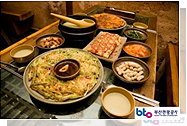
‘Dongnae green-onion pancake’ is the native local food designated by Busan city, which is made with the regional local specialties of green-onion and seafood. In the age of Chosun, it was even served to kings. That is how much it has the deep taste of tradition. Only the heart of green-onion is used, so it’s soft not too strong, and fresh seafood is also mixed to make you feel the taste of spring. ▶ #367-2, Bokcheon-dong, Dongnae-gu, Busan
- Dwaeji Gukbap (Pork and Rice Soup)
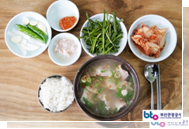
A Busan specialty dish, Dwaeji Gukbap is a pork-based soup and rice dish which is perfect for cold or rainy days. Theories abound about the origin of the soup. Some say it was invented during the Korean War when peasants would gather pork bones discarded by the US army and make a meal out of it. The broth is poured on steaming rice and is served with a variety of side dishes. Some people prefer to drink some soju. ▶ Getting there: Subway lines 1 and 2 to Seomyeon Station.
Near Lotte Department Store.- kkomjangeo
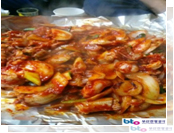
In a small alley at the edge of Jagalchi Market, are a number of pojangmacha (mobile cart bars) serving cooked sea eel. Although each of the carts has a small space for its customers, the owners of the carts are generous. The sea eel roasted over burning coal briquettes is particularly delicious. ▶ Getting there: Subway line 1 to Jagalchi Market (Exit 10) →
Jagalchi 1-gil → Entrance to Jagalchi Market- Busan Eomook
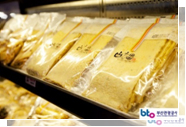
Eomuk is usually referred to as odaeng. Odaeng is a kind of fish cake, made of ground fish. This fish cake is skewered and boiled in water along with radish and green onions. This popular snack is especially loved during the cold winter months. Some variants also contain sausage, cheese or rice cakes. ▶ Getting there: Subway line 1 to Jagalchi Market Station (Exit 7)
→ Nampo intersection
→ BIFF Square, 300m in the direction of Gwangbok-ro
CITY TOUR BUS

- Loop Tour
- Tourism public transportation easily connecting Busan attractions by double-decker bus.
- By City Tour Course, you can be free to use three lines of Red Line(Busan Station <----> Haeundae), Blue Line(Haeundae <----> Younggungsa), and Green Lines(Oryukdo Islands<----> Hwangreyongsan Mt.) with one piece of one-day pass for a day without any additional charge.
- For Taejongdae Course (jumbo bus), a separate additional charge will occour at the time of transfer.
- City Tour Course



